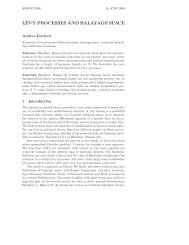Degenerate parabolic stochastic partial differential equations
Degenerate parabolic stochastic partial differential equations
Degenerate parabolic stochastic partial differential equations
Create successful ePaper yourself
Turn your PDF publications into a flip-book with our unique Google optimized e-Paper software.
4312 M. Hofmanová / Stochastic Processes and their Applications 123 (2013) 4294–4336<br />
Proof. Remark, that due to the construction of f ± it holds, for all p ∈ [1, ∞),<br />
<br />
<br />
E sup |u ± (x, t)| p dx = E sup |ξ|<br />
0≤t≤T T N 0≤t≤T<br />
T p dν N x,t ± (ξ) dx ≤ C. (22)<br />
R<br />
Now, we are able to prove that the modification u + is right-continuous in the sense of L p (T N ).<br />
According to Proposition 3.1 applied to the solution f + , we obtain<br />
<br />
f + (t + ε), ψ −→ f + (t), ψ , ε ↓ 0, ∀ψ ∈ L 1 (T N × R).<br />
Setting ψ(x, ξ) = ψ 1 (x)∂ ξ ψ 2 (ξ) for some functions ψ 1 ∈ L 1 (T N ) and ∂ ξ ψ 2 ∈ Cc ∞ (R), it reads<br />
<br />
<br />
ψ 1 (x)ψ 2 u + (x, t + ε) <br />
<br />
dx −→ ψ 1 (x)ψ 2 u + (x, t) dx. (23)<br />
T N T N<br />
In order to obtain that u + (t + ε) → w u + (t) in L p (T N ), p ∈ [1, ∞), we set ψ2 δ(ξ) = ξχ δ(ξ)<br />
where (χ δ ) is a truncation on R, i.e. we define χ δ (ξ) = χ(δξ), where χ is a smooth function<br />
with bounded support satisfying 0 ≤ χ ≤ 1 and<br />
⎧<br />
⎨<br />
1, if |ξ| ≤ 1 χ(ξ) =<br />
2 ,<br />
⎩<br />
0, if |ξ| ≥ 1,<br />
and deduce<br />
<br />
<br />
ψ<br />
1 (x) u + (x, t + ε) dx − ψ 1 (x) u + (x, t) dx<br />
T N T N <br />
<br />
<br />
≤<br />
ψ 1 (x) u + (x, t + ε) 1 |u + (x,t+ε)|>1/2δ dx<br />
T N <br />
+<br />
ψ<br />
1 (x)ψ δ <br />
T N 2 u + (x, t + ε) − ψ 1 (x)ψ2<br />
δ <br />
u + (x, t) dx<br />
<br />
<br />
<br />
+ ψ1 (x) u + (x, t) 1|u + (x,t)|>1/2δ dx −→ 0, ε ↓ 0,<br />
T N<br />
since the first and the third term on the right hand side tend to zero as δ → 0 uniformly in ε due<br />
to the uniform estimate (22) and the second one vanishes as ε → 0 for any δ by (23).<br />
The strong convergence in L 2 (T N ) then follows easily as soon as we verify the convergence<br />
of the L 2 (T N )-norms. This can be done by a similar approximation procedure, using ψ 1 (x) = 1<br />
and ψ2 δ(ξ) = ξ 2 χ δ (ξ). For the strong convergence in L p (T N ) for general p ∈ [1, ∞) we employ<br />
the Hölder inequality and the uniform bound (22).<br />
A similar approach then shows that the modification u − is left-continuous in the sense of<br />
L p (T N ). The rest of the proof, showing that u − (t) = u + (t) for all t ∈ [0, T ] can be carried out<br />
similarly to [9, Corollary 12]. □<br />
4. Existence—smooth initial data<br />
In this section we prove the existence part of Theorem 2.10 under an additional assumption<br />
upon the initial condition: u 0 ∈ L p (Ω; C ∞ (T N )), for all p ∈ [1, ∞). We employ the<br />
vanishing viscosity method, i.e. we approximate Eq. (1) by certain nondegenerate problems,<br />
while using also some appropriately chosen approximations Φ ε , B ε of Φ and B, respectively.



